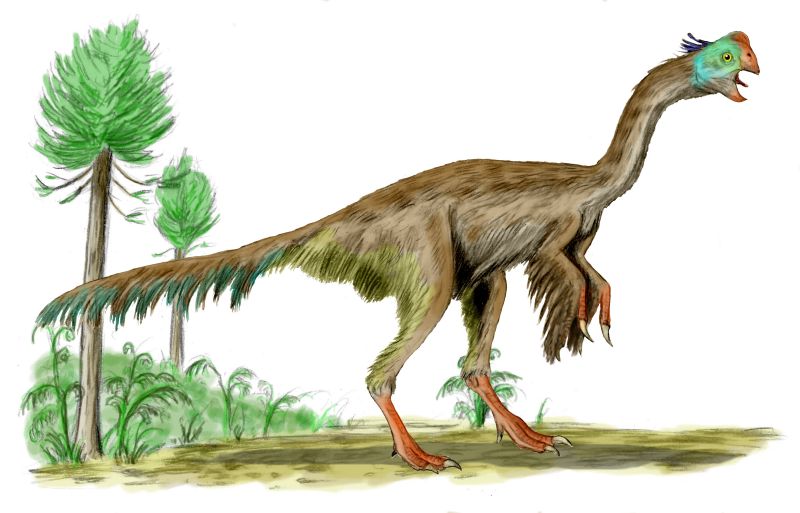- Gigantoraptor
Taxobox|
name = "Gigantoraptor"

fossil_range =Late Cretaceous
regnum =Animal ia
phylum =Chordata
classis = Sauropsida
superordo =Dinosaur ia
ordo =Saurischia
subordo =Theropoda
familia =Oviraptoridae
genus = "Gigantoraptor"
genus_authority = Xu "et al.", 2007
subdivision_ranks =Species
subdivision = "G. erlianensis" Xu "et al.", 2007 (type)"Gigantoraptor" is a
genus of giantoviraptorosauria ndinosaur that lived 85 million years ago during the lateCretaceous Period .Xu, X., Tan, Q., Wang, J., Zhao, X., and Tan, L. (2007). "A gigantic bird-like dinosaur from the Late Cretaceous of China." "Nature", 447(7146): 844-847.] It was discovered in 2005 in theIren Dabasu Formation , Erlian basin, inInner Mongolia . Xu "et al." found that it shared a common ancestor with and belonged to the same family as "Oviraptor ", but in comparison, "Gigantoraptor" was much larger, approximately 35 times larger than its likely close relative, "Caudipteryx ". [http://www.cbc.ca/technology/story/2007/06/13/tech-dinosaur.html Remains of giant bird-like dinosaur unveiled] CBC] At convert|8|m|ft|0 long and weighing about 1.4 tonnes it is nearly 3 times as long and much heavier than the largest oviraptorosaur hitherto known, "Citipati ".Its similarity to
birds includes anatomical features such as abeak instead oftooth ed jaws. No direct evidence offeathers was preserved with the skeleton, but the authors inferred their presence based on the fact that "Gigantoraptor" was a member of theOviraptorosauria , a group known to include many feathered species. Most unequivocalfeathered dinosaur s found to date are small; however, evidence suggests that other large oviraptorids such as "Citipati", as well astherizinosaur s such as "Beipiaosaurus ", almost certainly had feathers as well.Paul, G.S. (2002). "Dinosaurs of the Air: The Evolution and Loss of Flight in Dinosaurs and Birds." Baltimore: Johns Hopkins University Press.]The diet of this animal is a mystery. Although some oviraptorosaurs such as "
Incisivosaurus " are thought to have been mostly herbivorous, "Gigantoraptor" had hind legs with proportions that allowed for fast movement (it was probably more nimble than the ponderous "Tyrannosaurus "), and large claws, a combination that is not usually found in herbivores of this size.The only known specimen (LH V0011) is the incomplete and disassociated remains of a single individual that died at an estimated 11 years of age (determined from growth lines in one of the leg bones), and therefore possibly not full-grown. Its discovery was documented on film:
Xu Xing reenacted the discovery of asauropod for a Japanese documentary. As he wiped the bone clean, he realized it was not from a sauropod, but from an unidentifiable theropod in the size class of "Albertosaurus ". He then stopped the filming to secure the serendipitous find.References
External links
* [http://www.nature.com/news/2007/070611/full/070611-9.html "news@nature.com"] : "Giant bird-like dinosaur found".
* [http://blog.wired.com/photos/uncategorized/2007/06/13/dinosaur_skeleton_2.jpgSkeletal reconstruction] of a "Gigantoraptor" raising itself up on one foot. Known bones are white. Human is 175cm tall. Credit: Li Rongshan/IVPP.
* [http://csotonyi.com/Gigantoraptor_erlianensis.html Fleshed-out restoration of a "Gigantoraptor".] Credit: Julius T. Csotonyi
* [http://news.yahoo.com/s/nm/china_dinosaurs_dc Yahoo! News] : China finds new species of big, bird-like dinosaur
* [http://www.dinosaurier-web.de/galery/pages_g/gigantoraptor.html Description] : Factsheet with picture english/german at Dinosaurier-Web
Wikimedia Foundation. 2010.
